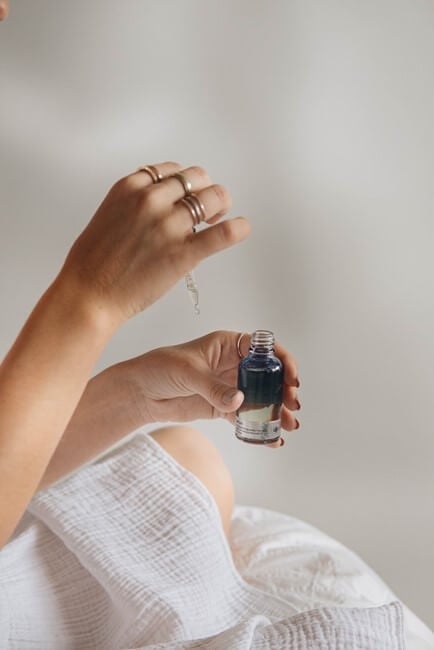Have you ever seen the word “cica” on skincare products and wondered what it really means? In this article, we will reveal the true meaning of cica, its benefits for your skin, and what types of products you can find on the market to help you incorporate cica into your skincare routine.
WHAT DOES “CICA” MEAN?
The word cica is a shortened way of referring to
Centella asiatica
in skincare products. Also known as Gotu Kola, Bua-bok, Tiger grass, or Indian Pennywort, this traditional plant has been used for centuries, particularly in Southeast Asia, due to its many nutritional and therapeutic properties [1].
WHAT’S THE HYPE ABOUT CICA?
In recent years, the use of cica has become widespread in South Korea in a myriad of skincare products. The global popularization of K-beauty has put this star ingredient in the spotlight of skincare routines specifically aimed at soothing, calming, and moisturizing the skin.
From a scientific point of view,
Centella asiatica
has also gained fame due to the various substances that are part of its chemical composition, which are responsible for the numerous beneficial effects that cica can offer to the skin.
The most important active constituents of
Centella asiatica
are the “centelloids” group, including madecassoside, asiaticoside, asiatic acid, and madecassic acid [2]. Other compounds found in
Centella asiatica
extracts include different types of flavonoids, phenolic acids, phytosterols, amino acids, vitamins, and sugars [3].
SKIN BENEFITS OF CICA
Several skin effects are supporting the use of
Centella asiatica
as an active ingredient in skincare formulations. Four of the main ones are listed below:
1.
Anti-inflammatory and soothing effect

Centella asiatica
extract has been shown to exert an anti-inflammatory effect when applied to the skin, making it a great skin-soothing agent.
An in vivo evaluation [3] of two cosmetic formulations (an emulsion and a hydrogel) containing 5% of
C. asiatica
extract, evidenced the ability of cica to significantly reduce the erythema (aka redness) induced upon application of an experimental inflammatory agent on human skin. The results of the study proved that formulations containing cica may have a
protective effect
on the skin,
alleviating skin redness and its sensitivity to irritants.
The anti-inflammatory activity was associated with cica’s centelloids, known to inhibit inflammatory enzymes’ activity and proinflammatory cytokines.
This anti-inflammatory effect has been associated with beneficial results in supporting the treatment of skin prone to eczema, also known as atopic dermatitis [4].
2.
Moisturizing effect and improvement of skin barrier function.

Cica has also been used as a
moisturizing agent
, specifically to complement the skincare treatment of dry and sensitive skin types .
The same in vivo study previously mentioned [4] also proved how effective
C. asiatica
was in increasing skin moisture by two mechanisms: 1) by inducing an increase of skin surface hydration state, and 2) by decreasing the transepidermal water loss (TEWL), which is a measure of the improvement of the barrier function of the skin.
Specifically, the emulsion containing 5% of
C. asiatica
extract showed the greatest impact on the skin hydration and epidermal barrier function, especially on the epidermal barrier tightness, which was attributed to the presence of carbohydrates (such as sugars), but also to the centelloids, flavonoids, and phenolic compounds present [4].
Moreover, cica’s beneficial effects were also compared to that of ceramides in another in vivo study [5], in which researchers evidenced that
C. asiatica
could be as effective as ceramides in improving the skin barrier and hydration in dry skin susceptible to irritation.
3.
Wound healing effect

From a therapeutical point of view,
C. asiatica
is is most widely known for its use in the treatment of wounds, burns, and scars (including stretchmarks).
C. asiatica
extracts have been shown to positively influence wound healing by improving type I collagen synthesis and microcirculatory function [1]. Asiaticoside is believed to play a major role in this activity, increasing the tensile strength of the newly formed skin, furthering the healing of the wounds, along with exerting an anti-inflammatory activity [6].
Some studies have shown that wounds treated with
C. asiatica
can significantly repair faster and reduce in size compared to untreated control wounds [6].
4.
Antioxidant and antiaging properties

Oxidative stress plays an important role in skin aging, being considered one of the main responsible factors associated with the damage of important structural and cellular molecules, such as collagen.
In cosmetology,
C. asiatica
has been used as an effective anti-aging ingredient, due to its ability to induce the synthesis of type I collagen, which amount in the skin decreases with age [2], and it’s antioxidant activity able to fight free radicals due to the presence of distinctive compounds such as flavonoids and phenolic acids [3].
Research [7] has shown that
C. asiatica
can promote the capacity of fibroblasts to combat oxidative stress by upregulating the cellular antioxidant enzymes and further inhibit matrix metalloproteinases (enzymes involved in collagen degradation), which helps the skin preserve its firmness and elasticity.
HOW TO INCLUDE CICA IN YOUR SKINCARE ROUTINE?
The main cica-based skincare products available on the market focus primarily on their ability to soothe, calm, repair, and moisturize the skin, focusing especially on sensitive skin types prone to irritation and redness.
Let’s take a look at some products you may want to include in your
skincare routine
to take advantage of some of the many benefits of cica.
-
Cica cleansers:

Cica-based facial cleansers are often formulated to be suitable for sensitive skin, being mild and gentle to respect the skin barrier integrity, without the risk of drying it out. Nonetheless, these formulas can be adapted to almost any skin type, making them a great option to include in your skincare routine as your daily cleanser.
Some alternatives you can find include:
NUDESTIX Cica Cleansing Jelly Milk Face Cleanser.
Kiehl’s Centella Sensitive Facial Cleanser.
BANILA CO Clean it Zero Purifying Foam Cleanser (containing 8
Centella Asiatica
-derived ingredients).
Skincare routine order:
cleansers are the first step of any
skincare routine
.
-
Cica serums and ampoules:

Another option to boost your skincare routine is to include cica-based serums or ampoules. These are lightweight water-based products intended to deliver high concentrations of active ingredients into your skin. They are likely to be suitable for all skin types.
Some alternatives you can find include:
Dr. Jart+ Cicapair™ Tiger Grass Serum, which targets skin redness and irritation.
bliss Ever Dew Skin Enhancing Glowy Serum, which contains cica combined with niacinamide and
vitamin C
to support skin condition and radiance.
SKIN1004 – Madagascar Centella Ampoule, a K-beauty product formulated with 100%
Centella asiatica
extract, to soothe and hydrate skin.
Skincare routine order:
serums and ampoules are applied after proper washing or cleansing step, before moisturizing cream.
-
Cica creams:

Most creams containing cica are specifically formulated for sensitive and/or dry skin types which are prone to irritation and redness, thus claiming to protect, repair and restore the skin barrier.
If this is your case, some alternatives you can try are:
Dr. Jart+ Cicapair™ Tiger Grass Calming Gel Cream (for normal to oily skin types), or Cream (for dry to normal skin types).
La Roche-Posay CICAPLAST Baume B5, enriched with madecassoside from cica. For face, lips, and body.
Kiehl’s Centella Sensitive Cica-Cream, enriched with madecassoside from cica.
Bioderma Cicabio Cream, enriched with asiaticoside, asiatic acid and madecassic acid from cica. For face, lips, and body.
Skincare routine order:
creams are normally applied after your serum or directly after cleansing (if no serum is used), either in the morning and/or at night (see instructions for your specific product).
-
Cica sleeping masks:

You can opt for sleeping masks infused with cica, for a night-intensive treatment to soothe and moisturize the skin.
Some alternatives you can find include:
LANEIGE Cica Sleeping Mask, which improves dryness and redness, and contains isolated asiaticoside, madecassic acid, and aspartic acid from cica.
Dr. Jart+ Cicapair™ Tiger Grass Sleepair Intensive Mask.
Skincare routine order:
as the last step of the night routine. Use it once or twice per week.
-
Cica color correctors with SPF:

If redness and blemishes are your skin concern, you can also benefit from products formulated to correct and cover your skin’s redness and even skin tone. They are meant to be used during the day, providing additional SPF so you can further protect your skin during the day from the detrimental effects of UV light exposure.
Some alternatives you can find include:
Dr. Jart+ Cicapair™ Tiger Grass Color Correcting Treatment SPF 30
Dr. Jart+ Cicapair ™ Tiger Grass Camo Drops Color Corrector SPF 35
Skincare routine order:
as part of your morning routine after moisturizing cream. You can follow up with makeup.
THE TAKEAWAY
Centella Asiatica
(aka cica) is a natural source of active compounds of interest in the cosmetic field, mainly due to the presence of centelloids such as asiaticoside and madecassoside. Cica can be found in many skincare products with a particular focus on soothing, repairing, protecting, and hydrating the skin, mainly -but not exclusively- for those prone to irritation, redness, and dryness.
REFERENCES
[1] Arribas-López, E., Zand, N., Ojo, O., Snowden, M. J., & Kochhar, T. (2022). A Systematic Review of the Effect of Centella asiatica on Wound Healing. International Journal of Environmental Research and Public Health, 19 (6), 3266. https://doi.org/10.3390/ijerph19063266
[2] Bylka, W., Znajdek-Awiżeń, P., Studzińska-Sroka, E., & Brzezińska, M. (2013). Centella asiatica in cosmetology. Postepy Dermatologii I Alergologii, 1, 46–49. https://doi.org/10.5114/pdia.2013.33378
[3] Ratz-Łyko, A., Arct, J., & Pytkowska, K. (2016). Moisturizing and anti-inflammatory properties of cosmetic formulations containing Centella asiatica extract. Indian Journal of Pharmaceutical Sciences, 78 (1), 27. https://doi.org/10.4103/0250-474x.180247
[4] Sun, B., Wu, L., Wu, Y., Zhang, C., Qin, L., Hayashi, M., Kudo, M., Gao, M., & Liu, T. (2020). Therapeutic Potential of Centella Asiatica and Its Triterpenes: A Review. Frontiers in Pharmacology, 11. https://doi.org/10.3389/fphar.2020.568032
[5] Anggraeni, S., Umborowati, M. A., Damayanti, D., Endaryanto, A., & Prakoeswa, C. R. S. (2021). Role of Centella Asiatica and ceramide in skin barrier improvement: a double-blind clinical trial of Indonesian batik workers. Journal of Basic and Clinical Physiology and Pharmacology, 32 (4), 589–593. https://doi.org/10.1515/jbcpp-2020-0510
[6] Gohil, K. J., Patel, J. A., & Gajjar, A. K. (2010). Pharmacological review on Centella Asiatica: A potential herbal cure-all. Indian Journal of Pharmaceutical Sciences, 72 (5), 546. https://doi.org/10.4103/0250-474x.78519
[7] Buranasudja, V., Rani, D., Malla, A., Kobtrakul, K., & Vimolmangkang, S. (2021). Insights into antioxidant activities and anti-skin-aging potential of callus extract from Centella asiatica (L.). Scientific Reports, 11 (1). https://doi.org/10.1038/s41598-021-92958-7

 By myulikeadmin
By myulikeadmin



